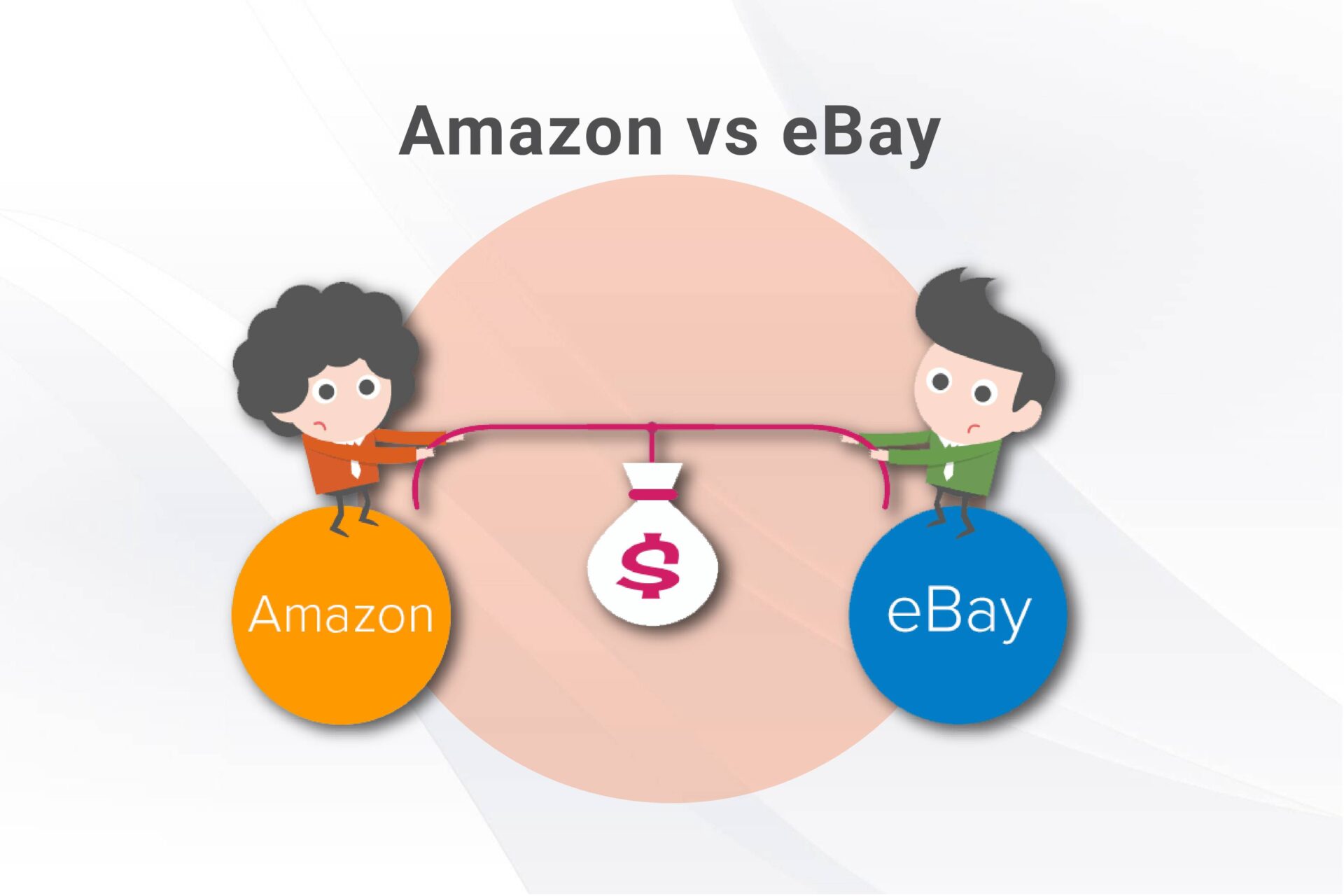
Selling on Amazon vs. eBay – A Comparative Guide
Whether you are a seasoned seller or a newbie just stepping into the eCommerce world, the question of whether you should be selling on Amazon or eBay must have crossed your mind at some point.
Like most things in life, the answer to this tricky question is not easy. While we recommend diversifying your marketplace by selling on Amazon and eBay together, the debate is still quite relevant.
It helps you decide which of these giant platforms you should start with or which should be your primary focus, given the features and specs of your products, business model, or target customer base.
In this article, we will compare Amazon and eBay across several parameters to help you decide which one is best for you. So without any further delay, let’s get started.
Selling on Amazon vs eBay: Key Difference between the Platforms
Sellers often ask: what is the difference between eBay and Amazon? Here is a list of key differences between both platforms. Make sure you know them before opting for either.
Amazon vs eBay: Business Model
First, let’s look at what sets these two platforms apart regarding business models.
- First, let’s look at what sets these two platforms apart regarding business models.
- Pricing: Both platforms Amazon and eBay, have a fixed-price model. However, eBay also allows for an auction format, which used to be it’s only pricing mode back when it started.
- Competing with the platform: eBay serves only as a marketplace and allows third-party sellers to list their products on its platform. While Amazon, on the other hand, has its own products – Amazon Essentials – listed on its platform, alongside listings of private label sellers and others.
- Restrictions: There are fewer restrictions on eBay than on Amazon. This means that you can easily offer more products to buyers on eBay.
Amazon vs eBay: Competition
Both platforms are at the top of the eCommerce business and offer significant competition to the sellers. Some sellers might price their products low to sell more quantities.
In contrast, others may market their product as having higher quality and thus sell it at higher prices. The critical thing to remember is that you do not enter into a price race on either platform, as it can cause a loss in the long run.
However, one aspect would give eBay a bit of an edge when measuring the level of competition on both sites. Amazon lists its own branded products alongside those from third-party sellers, which provides sellers with tough competition to sell their products in that niche. On the other hand, eBay provides a marketplace for others without selling its own branded products.
Amazon vs eBay: Customer Loyalty
There is no denying that both of these platforms enjoy massive outreach on a global level. However, eBay takes the lead in global outreach, as it generates a significant portion of its revenue from international markets.
Both of these marketplaces appeal to different customer bases. For instance, generally, the buyers on Amazon tend to be wealthier people who are married, have families, and have a higher education.
Similarly, around 54% of eBay shoppers tend to be male. However, in isolation, these stats may not give you any meaningful comparison. Some buyers would be loyal to one platform, while others would be willing to switch to another if they got a good deal.
The point to take home is that you need to understand your target customer base. Once you have done that, you should see where you will most likely find the people interested in your products.
Read More: Amazon Handmade vs Etsy: Which one is the Better Platform?
Amazon vs eBay: Profitability
How much revenue you generate and how much profit you make depend on various factors, including product pricing, shipping and handling costs, market competition, and product demand. Both Amazon and eBay offer opportunities for profitability, but it is up to the seller to make the most of them.
Amazon tends to offer a higher average selling price, which may result in higher profits, but it also charges higher fees for listing and selling products. On the other hand, eBay charges lower fees, but the average selling price is usually lower.
Ultimately, profitability will depend on the specific products being sold and the seller’s strategy. Both platforms have their pros and cons, and it’s up to the seller to determine which one will work best for them based on their business goals and products.
As we have discussed, profitability is more related to product research, and for this stance, you can look for market research experts like SPCTEK.
Amazon vs eBay: Ease of doing business
When it comes to restrictions and regulations, eBay beats Amazon by a significant margin. eBay’s policies for listing are much simpler than Amazon’s. Speaking of gated and ungated categories, Amazon, once again, has more regulations than eBay.
However, Amazon has got a fantastic order fulfillment scheme in the form of FBA (Fulfillment by Amazon). In FBA service, Amazon picks, packs, and ships items to customers, making selling on Amazon a lot easier and hassle-free of doing business for the sellers.
Amazon Selling Fees vs eBay Selling Fees
The following is the breakdown of Amazon vs eBay selling fees.
Amazon Selling Fees
To understand Amazon’s fee structure, you need to know how the FBA revenue calculator works. Here’s what it looks like:

Amazon fees vary based on the fulfillment method and product category. The picture on the left shows FBA fees and the one on the right shows FBM fees.
The following is the breakdown of the various types of fees you have to pay to Amazon. For the sake of explanation, we’ve entered a product priced $23.99.
Amazon fees: This fee is like a commission you have to pay Amazon for every product you sell. It ranges from 6 to 45% of the product price based on the category. The minimum fee is $1.
Fulfillment cost: This fee only applies if you use Amazon FBA for fulfillment and is determined by the weight and size of your product.
Storage cost: Amazon charges a monthly storage fee for every unit stored in its warehouses.
Other costs: This is not an Amazon fee; it refers to the cost of manufacturing and shipping your product to Amazon’s warehouse.
Closing fee: This applies to books and media-related items, including videos, video game consoles, and accessories.
Additional fees: Amazon offers two types of selling plans: Individual and Professional. Sellers opting for the individual plan have to pay $0.99 per item sold, while those with the professional plan pay a monthly fee of $39.99.
Also, sellers pay additional charges if they want to use special tools and features such as A+ Content. Amazon is strict about its fulfillment abilities and customer satisfaction and charges hefty fees for low inventory levels and over-storage.
Also Read: Amazon Policy Compliance: Protect Your Business and Boost Sales
eBay Selling Fees
eBay charges two main types of fees: insertion fee and final value fee.

Insertion fees: For most casual sellers, listing items on eBay is free. However, if you list more than 250 items in a month, a $0.35 insertion fee will apply to each additional listing. Note that this fee also applies to relisted items and is non-refundable, even if the item does not sell.
Final value fees: When you sell an item, eBay takes a percentage of the sale as a final value fee, which varies by category but is capped at 13.25%. Additionally, there is a per-order fee: $0.30 for orders of $10.00 or less, and $0.40 for orders above $10.00.
Additional Fees: Sellers pay listing upgrade fees if they use special features to enhance their listings. These features include bold fonts, subtitles, and setting a minimum sale price for an item.
Sellers can be charged additional final value fees if they fail to meet performance metrics or buy or sell outside of the platform.
For more details, visit eBay’s Selling Fees page.
Also Read: How to Create Top-Selling eBay Listing in 10 Steps
Is it Cheaper to Sell on Amazon or eBay?
eBay’s fees might seem a bit complicated, but they’re usually slightly lower than Amazon’s—though not by much. The exact fees depend on the type of product, its size, and how it’s shipped.
Is it Better to Sell on eBay or Amazon?
There is no clear answer to this question. However, Amazon provides more tools that make selling on Amazon more manageable. Amazon’s Celler Central gives critical insights into various aspects of your business and customer behavior which helps in making data-backed decisions. Although it’s slightly more expensive to sell on Amazon.
In terms of competition, both platforms have intense competition with millions of sellers.
Amazon vs eBay statistics
In terms of market share and revenue, Amazon beats eBay by a huge margin. In the United States, Amazon claimed the lion’s share with almost 38% of the e-commerce market securing the top spot among online retailers in 2023. Compared to that, eBay had a meager share of 3% only.
The difference in revenue is even more pronounced. eBay’s revenue for the twelve months ending September 30, 2024, was $10.266B, a 2.05% increase year-over-year, while Amazon’s revenue for the same period was a whopping $620.128B, an 11.93% increase year-over-year.
Final Thoughts
The bottom line is that there are many differences between selling on Amazon and eBay. You need to decide which platform suits your business the most and where you should start. Once you have established yourself on one platform, it is always a good idea to branch out to the other platforms. If you are planning on starting your journey as a seller on Amazon or eBay, SPCTEK is here to help you with that. We excel at providing premium services for complete account management for Amazon and eBay. We will be happy to help you get started on a new path in eCommerce.
FAQ’s
New, branded products with fixed prices tend to perform well on Amazon due to its customer base seeking convenience and reliability. eBay is well-suited for unique, vintage, collectible, or niche products, as well as used items and auctions.
Both platforms have buyer protection programs, but their return policies and processes may vary. Amazon typically has stricter return policies and offers A-to-Z Guarantee protection for buyers. eBay allows sellers to set their own return policies, with options for returns within specified timeframes and conditions.
Yes, many sellers utilize both Amazon and eBay simultaneously to reach different audiences and diversify their sales channels. However, managing inventory, listings, and fulfillment across multiple platforms requires careful coordination and may incur additional operational challenges.
Online businesses can be risky. That’s why both Amazon and eBay have safety measures in place to protect their buyers and sellers. But Amazon is a bit safer as it handles the payments to the sellers itself.















